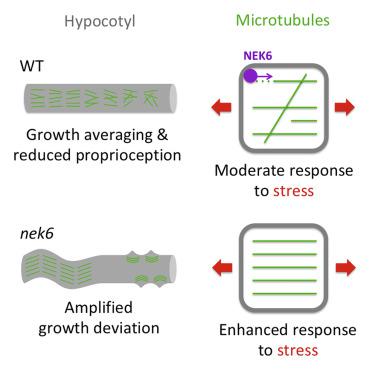当前位置:
X-MOL 学术
›
Curr. Biol.
›
论文详情
Our official English website, www.x-mol.net, welcomes your
feedback! (Note: you will need to create a separate account there.)
Microtubule Response to Tensile Stress Is Curbed by NEK6 to Buffer Growth Variation in the Arabidopsis Hypocotyl.
Current Biology ( IF 8.1 ) Pub Date : 2020-03-12 , DOI: 10.1016/j.cub.2020.02.024 Shogo Takatani 1 , Stéphane Verger 2 , Takashi Okamoto 3 , Taku Takahashi 3 , Olivier Hamant 2 , Hiroyasu Motose 3
Current Biology ( IF 8.1 ) Pub Date : 2020-03-12 , DOI: 10.1016/j.cub.2020.02.024 Shogo Takatani 1 , Stéphane Verger 2 , Takashi Okamoto 3 , Taku Takahashi 3 , Olivier Hamant 2 , Hiroyasu Motose 3
Affiliation

|
Growth variability generates mechanical conflicts in tissues. In plants, cortical microtubules usually align with maximal tensile stress direction, thereby mechanically reinforcing cell walls, and channeling growth rate and direction. How this is achieved remains largely unknown and likely involves microtubule regulators. The NIMA-related microtubule-associated kinase NEK6 phosphorylates tubulin, leading to the depolymerization of a subset of microtubules. We found that cortical microtubules exhibit a hyper-response to mechanical stress in the nek6 mutant. This response contributes to local cell protrusions in slow-growing regions of the nek6 mutant hypocotyl. When growth amplitude is higher, the hyper-alignment of microtubules leads to variable, stop-and-go, phenotypes, resulting in wavy hypocotyl shapes. After gravistimulation or touch, the nek6 mutant also exhibits a hyperbent hypocotyl phenotype, consistent with an enhanced perception of its own deformation. Strikingly, we find that NEK6 exhibits a novel form of polarity, being recruited at the ends of a subset of microtubules at cell edges. This pattern can be modified after local ablation, matching the new maximal tensile stress directions. We propose that NEK6 depolymerizes cortical microtubules that best align with maximal tensile stress to generate a noisier network of microtubules. This prevents an overreaction of microtubules to growth fluctuations and, instead, promotes the buffering of growth variations.
中文翻译:

NEK6抑制拟南芥下胚轴缓冲液生长变化的微管对拉应力的响应。
生长变异性会在组织中产生机械冲突。在植物中,皮层微管通常与最大拉应力方向对齐,从而机械增强细胞壁,并引导生长速率和方向。如何实现这一点在很大程度上仍然未知,并且可能涉及微管调节器。NIMA相关的微管相关激酶NEK6使微管蛋白磷酸化,从而导致一部分微管解聚。我们发现皮质微管在nek6突变体中表现出对机械应力的过度反应。此反应有助于nek6突变体下胚轴的缓慢生长区域中的局部细胞突起。当生长幅度更高时,微管的高度排列会导致可变的,停停走走的表型,从而导致下胚轴呈波浪形。经过去毛刺或触摸后,nek6突变体还表现出过高的下胚轴表型,与其对自身变形的感知增强有关。令人惊讶地,我们发现NEK6表现出一种新型的极性,被募集到细胞边缘的微管子集的末端。可以在局部消融后修改此图案,以匹配新的最大拉伸应力方向。我们建议NEK6解聚皮质微管,最大程度地与最大拉应力对齐,以产生噪声较大的微管网络。这防止了微管对生长波动的过度反应,而是促进了生长变异的缓冲。被募集到细胞边缘的微管子集的末端。可以在局部消融后修改此图案,以匹配新的最大拉伸应力方向。我们建议NEK6解聚皮质微管,最大程度地与最大拉应力对齐,以产生噪声较大的微管网络。这防止了微管对生长波动的过度反应,而是促进了生长变异的缓冲。被募集到细胞边缘的微管子集的末端。可以在局部消融后修改此图案,以匹配新的最大拉伸应力方向。我们建议NEK6解聚皮质微管,最大程度地与最大拉应力对齐,以产生噪声较大的微管网络。这防止了微管对生长波动的过度反应,而是促进了生长变异的缓冲。
更新日期:2020-04-20
中文翻译:

NEK6抑制拟南芥下胚轴缓冲液生长变化的微管对拉应力的响应。
生长变异性会在组织中产生机械冲突。在植物中,皮层微管通常与最大拉应力方向对齐,从而机械增强细胞壁,并引导生长速率和方向。如何实现这一点在很大程度上仍然未知,并且可能涉及微管调节器。NIMA相关的微管相关激酶NEK6使微管蛋白磷酸化,从而导致一部分微管解聚。我们发现皮质微管在nek6突变体中表现出对机械应力的过度反应。此反应有助于nek6突变体下胚轴的缓慢生长区域中的局部细胞突起。当生长幅度更高时,微管的高度排列会导致可变的,停停走走的表型,从而导致下胚轴呈波浪形。经过去毛刺或触摸后,nek6突变体还表现出过高的下胚轴表型,与其对自身变形的感知增强有关。令人惊讶地,我们发现NEK6表现出一种新型的极性,被募集到细胞边缘的微管子集的末端。可以在局部消融后修改此图案,以匹配新的最大拉伸应力方向。我们建议NEK6解聚皮质微管,最大程度地与最大拉应力对齐,以产生噪声较大的微管网络。这防止了微管对生长波动的过度反应,而是促进了生长变异的缓冲。被募集到细胞边缘的微管子集的末端。可以在局部消融后修改此图案,以匹配新的最大拉伸应力方向。我们建议NEK6解聚皮质微管,最大程度地与最大拉应力对齐,以产生噪声较大的微管网络。这防止了微管对生长波动的过度反应,而是促进了生长变异的缓冲。被募集到细胞边缘的微管子集的末端。可以在局部消融后修改此图案,以匹配新的最大拉伸应力方向。我们建议NEK6解聚皮质微管,最大程度地与最大拉应力对齐,以产生噪声较大的微管网络。这防止了微管对生长波动的过度反应,而是促进了生长变异的缓冲。











































 京公网安备 11010802027423号
京公网安备 11010802027423号